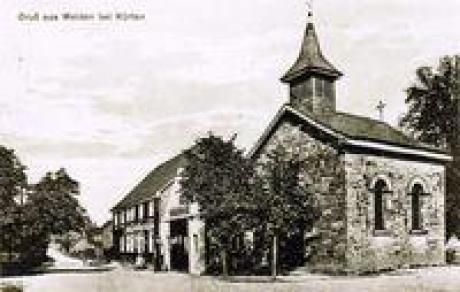“St. Anna Chapel Kürten” in Weiden
Ute Jülich
Version dated November 2nd, 2021
Location on the long-distance trade route
The location of the chapel on the old trade route, the "hehren (high) Weg", was certainly not chosen by chance. The location meant that the people of Weiden had their venerated saint very close by and offered passing traders and travelers a place where they could ask St. Anne for protection and help for their journey.
The relationship between the chapel and the mother church in Kürten was always very close. Even today, local residents look after the small chapel, as they have done for centuries.
In earlier times, church services were celebrated several times a year: on St. Anne's Day on July 26 and on February 22, the "Pitteschdaach" (St. Peter's Day), which played an important role in the everyday lives of the residents.
On this day, servants and maids changed their employer if they wanted to change jobs and it was the deadline for paying interest and repaying debts.
(3)
Until recently, a well-attended church service was held every week. However, not much is left of the fair at the end of July, which lasted several days and included a festive church service, dancing, fairground stalls and merry-go-rounds.
(7)
Veneration of St. Anne
Saint Anne was venerated early on in the Eastern Roman Empire. The cult reached Rome when a relic (part of the skullcap) of the saint was brought to the collegiate church in Mainz in 1202, where it was highly venerated as a treasure. A special incident brought the relic to Düren on the Lower Rhine: a young stonemason from Cornelimünster stole the head relic during his work in the summer of 1500 and brought it back to his home, to the parish church of St. Martin in Düren. After the relic's presence in Düren became known, numerous miracles attributed to St. Anne caused a huge sensation in the town and all around the Jülich and Cologne region.
At the beginning of the 16th century, devotion to St. Anne, the mother of Mary, spread rapidly throughout the Lower Rhine region, especially in the duchies of Jülich and Berg.
(2)
The chapel in Weiden was one of the first to be dedicated to St. Anne in the Bergisches Land region. In Düren, the numerous pilgrimages from the surrounding area brought the town a certain prosperity at the time. The annual St. Anne's Fair in Düren has survived to this day and is one of the largest public festivals in the whole of Germany.
After 1945, devotion to St. Anne in West Germany experienced a revival due to the displaced persons from Silesia, who had lost a central place of pilgrimage for their devotion to St. Anne in St. Annaberg.

The building
The Anna Chapel was built from local quarry stone with a floor plan of 7.15 m x 5 m and a three-sided apse. On the roof there is a ridge turret as a bell tower, in which a bell from the church of St. Johann Baptist in Kürten is said to be located. The long sides are each adorned with two arched windows. An inscription above the portal refers to the first restoration in 1708 under Pastor Breidenbach from Kürten, who also had the vicarage built in Kürten. After a major fire destroyed the Weiden farm and the neighboring chapel down to the foundation walls in 1836, it was rebuilt by the residents as part of the reconstruction of the farm. The chapel escaped with relatively little damage during the bombing raid on Weiden and Herweg on February 10, 1945.
Interior decoration
When Heinrich Pohl, who grew up next to the chapel, celebrated his first mass in the chapel in 1947, the interior of the little church was refurbished by the neighborhood. With an altar, communion bench, kneeling benches, new windows and lamps, it was given a completely new interior.
The last major renovation took place on the occasion of the 500th anniversary celebrations in 2007, when the walls, roof and electrical installations were completely renovated. Some of the interior furnishings were also renewed. The two new windows designed by the Silesian artist Franz Toenniges are worth seeing: he chose a depiction of St. Hedwig (patron saint of Silesia) and one of St. Anna-Selbdritt (depiction of St. Anna and her daughter Mary with the baby Jesus.) The glass artist Maria Schätzmüller-Lukas from Kürten was responsible for the realization.
(7)
The documentation on the exhibition "500 years of St. Anne's Chapel", which Franz Toenniges designed on 20 display panels, is kept in the Kürten municipal archives.
The surroundings of the chapel
It can be assumed that a place to rest was established next to the chapel at an early date. Around 1715, there were three farms in Weiden. Today's inns "Zur Kapelle" (Adolf Kürten) and "Zur Schmiede" (Wilhelm Pohl) next to the chapel were popular places to stop in the 19th and 20th centuries and were the social center of the village until a few years ago.
Sources:
(1) Opladen, Peter: The deanery of Wipperfürth (1956)
(2) Jux, Anton: How the Annen Chapel in Weiden near Kürten came into being - Rheinisch Bergischer Kalender 1960
(3) Lorry, Peter: The Anna Chapel in Weiden - Rheinisch Bergischer Kalender 1962
(4) Büchel, Josef / Förster, Kunibert: 500 years of the Anna Chapel in Weiden - Kürtener Schriften 2007
(5) Weber, B. Förster, K. Büchel, J.: The Anna Chapel in Weiden - Kürtener Schriften 2011
(6) Fuchs, Ulrich: St. Anna Chapel in Weiden - Parish Council, Weiden 2002
(7) Wikipedia: St. Anna, Weiden. Parishes.erzbistum-koeln.de
(8) Panofsky-Soergel: The Monuments of the Rhineland Vol. 3








